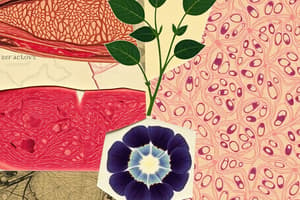Podcast
Questions and Answers
What structure replaces the epidermis in older woody plants during secondary growth?
What structure replaces the epidermis in older woody plants during secondary growth?
- Cuticle
- Stomata
- Periderm (correct)
- Trichomes
Which substance is responsible for the waterproofing of cork cells in the periderm?
Which substance is responsible for the waterproofing of cork cells in the periderm?
- Cellulose
- Lignin
- Suberin (correct)
- Chlorophyll
What is the primary function of root hairs in plant epidermis?
What is the primary function of root hairs in plant epidermis?
- Light reflection to cool tissues
- Protection against herbivores
- Gas exchange
- Increasing surface area for water absorption (correct)
What are lenticels primarily involved in within the plant structure?
What are lenticels primarily involved in within the plant structure?
What is the primary function of meristematic cells in flowering plants?
What is the primary function of meristematic cells in flowering plants?
Which type of tissue is primarily responsible for increasing the length of stems and roots in flowering plants?
Which type of tissue is primarily responsible for increasing the length of stems and roots in flowering plants?
What role do trichomes play in the adaptation of plants to their environment?
What role do trichomes play in the adaptation of plants to their environment?
In herbaceous plants, which tissue system makes up the outer protective covering?
In herbaceous plants, which tissue system makes up the outer protective covering?
What is an apical meristem's primary role in plant development?
What is an apical meristem's primary role in plant development?
Which of the following statements is true about meristematic cells?
Which of the following statements is true about meristematic cells?
Flashcards are hidden until you start studying
Study Notes
Cells and Tissues of Flowering Plants
- Meristematic cells are undifferentiated and capable of indefinite division, producing specialized cells as the plant embryo develops.
- Apical meristems at stem and root tips facilitate the growth in length of these tissues.
- Primary tissue systems formed by apical meristems include epidermal, ground, and vascular tissues.
Plant Tissue System: Dermal Tissue
- Dermal tissue serves as the outer protective layer; the epidermis covers herbaceous plants and is replaced by periderm in woody plants.
- Waxy cuticles on some epidermal cells reduce water loss, while root hairs enhance water absorption surface area.
- Trichomes on stems, leaves, and reproductive organs aid in protection against sunlight, herbivores, and excessively salty environments.
- Stomata on the lower leaf surface support gas exchange; cork cambium produces periderm during secondary growth in older woody plants.
Plant Tissue System: Ground Tissue
- Comprises the bulk of flowering plants, located between dermal and vascular tissues.
- Functions primarily for support and storage; composed of parenchyma, collenchyma, and sclerenchyma cells.
- Parenchyma cells are versatile, involved in photosynthesis and storage, and can differentiate into specialized cells.
- Collenchyma provides flexible support, particularly in new growth areas with thicker primary walls.
Plant Tissue System: Vascular Tissue
- Phloem consists of sieve tube members and companion cells, which are integral in nutrient transport and support.
- Sclerenchyma fibers within vascular tissue offer structural support.
- Eudicot and monocot plants show distinct tissue distribution patterns in stems and roots.
Types of Animal Tissue
- Animal tissues are classified into four main types: epithelial, connective, muscular, and nervous, each serving specific functions.
- Epithelial tissue covers body surfaces and cavities, while connective tissue binds and supports body parts.
- Muscular tissue facilitates movement, and nervous tissue is involved in stimulus reception and impulse transmission.
Animal Tissue: Epithelial Tissue
- Composed of tightly packed cells forming continuous layers with protective, secretion, absorption, excretion, and filtration functions.
- Types include simple epithelium (single cell layer) and stratified epithelium (multiple layers) with subtypes such as cuboidal, squamous, and columnar cells.
- Glandular epithelia secrete substances; exocrine glands release products via ducts while endocrine glands secrete directly into the bloodstream.
Animal Tissue: Connective Tissue
- Most diverse tissue type providing structure, support, protection, and energy storage; includes specialized cells, ground substances, and protein fibers.
- Classifications consist of fibrous (loose and dense), supportive (cartilage and bone), and fluid connective tissues (blood and lymph).
- Fibroblasts are common cells in fibrous connective tissue, while ground substances vary from solid to fluid states, supporting various functions.
Functions and Locations of Connective Tissue
- Loose fibrous connective tissue supports internal organs, allows expansion, and underlies the epidermis.
- Supportive connective tissues like cartilage and bones provide structural integrity and leverage.
- Blood and lymph serve as fluid connective tissues, involved in transportation of cells and nutrients throughout the body.
Studying That Suits You
Use AI to generate personalized quizzes and flashcards to suit your learning preferences.




